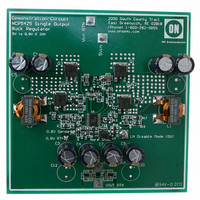NCP5425SOEVB ON Semiconductor, NCP5425SOEVB Datasheet - Page 16

NCP5425SOEVB
Manufacturer Part Number
NCP5425SOEVB
Description
EVAL BOARD FOR NCP5425SO
Manufacturer
ON Semiconductor
Specifications of NCP5425SOEVB
Design Resources
NCP5425SOEVB BOM NCP5425SOEVB Gerber Files NCP5425SOEVB Schematic
Main Purpose
DC/DC, Step Down
Outputs And Type
1, Non-Isolated
Voltage - Output
0.8V
Current - Output
30A
Voltage - Input
4.6 ~ 12 V
Regulator Topology
Buck
Frequency - Switching
300kHz
Board Type
Fully Populated
Utilized Ic / Part
NCP5425
Lead Free Status / RoHS Status
Lead free / RoHS Compliant
Power - Output
-
Lead Free Status / Rohs Status
Lead free / RoHS Compliant
For Use With/related Products
NCP5425SO
Other names
NCP5425SOEVBOS
where:
switching MOSFET conduction losses can be calculated by:
where:
switch−on and switch−off, and can be calculated by:
where:
then be calculated as:
where:
known, the maximum FET switch junction temperature can
be calculated:
where:
Once the RMS current through the switch is known, the
Upper MOSFET switching losses occur during MOSFET
The total power dissipation in the switching MOSFET can
Once the total power dissipation in the switching FET is
P HFET(TOTAL) + P RMS(H) ) P SWH(ON) ) P SWH(OFF)
I
I
I
D = duty cycle.
P
I
R
P
P
V
I
T
TFALL = MOSFET fall time (from FET manufacturer’s
T = 1/f
P
P
P
P
T
T
P
R
RMS(H)
L(PEAK)
L(VALLEY)
RMS(H)
OUT
RMS(H)
SWH(ON)
SWH(OFF)
HFET(TOTAL)
RMS(H)
SWH(ON)
SWH(OFF)
A
HFET(TOTAL)
RISE
J
DS(ON)
qJA
IN
= FET junction temperature;
= ambient temperature;
= input voltage;
P SWH + P SWH(ON) ) P SWH(OFF)
= upper FET junction−to−ambient thermal
= load current;
=MOSFET rise time (from FET manufacturer’s
SW
T J + T A ) [ P HFET(TOTAL)
resistance.
switching characteristics performance curve);
= maximum switching MOSFET RMS current;
= maximum switching MOSFET RMS current;
P RMS(H) + I RMS(H) 2
= FET drain−to−source on−resistance.
= switching MOSFET conduction losses;
= upper MOSFET switch conduction Losses;
= inductor peak current;
switching characteristics performance curve);
= upper MOSFET switch−on losses;
= period.
= upper MOSFET switch−on losses;
= upper MOSFET switch−off losses;
= upper MOSFET switch−off losses.
= inductor valley current;
+
= total switching (upper) MOSFET losses;
= total switching (upper) FET losses;
V IN
I OUT
6T
(t RISE ) t FALL )
R DS(ON)
R qJA ]
http://onsemi.com
NCP5425
16
Synchronous (Lower) FET Selection
calculated as follows:
where:
except for losses in the internal body diode, because it turns
on into near zero voltage conditions. The MOSFET body
diode will conduct during the non−overlap time and the
resulting power dissipation (neglecting reverse recovery
losses) can be calculated as follows:
where:
MOSFET can then be calculated as:
where:
is known the maximum FET switch junction temperature
can be calculated:
where:
The switch conduction losses for the lower FET are
The synchronous MOSFET has no switching losses,
The total power dissipation in the synchronous (lower)
Once the total power dissipation in the synchronous FET
P
I
D = Duty Cycle;
R
P
V
I
Non−overlap time = GATE(L)−to−GA TE(H) or
f
P
P
P
T
T
P
R
P SWL + V SD
OUT
LOAD
SW
RMS(L)
SWL
LFET(TOTAL)
RMS(L)
SWL
A
LFET(TOTAL)
J
DS(ON)
qJA
SD
= MOSFET junction temperature;
P RMS(L) + I RMS 2
= ambient temperature;
= switching frequency.
= lower FET source−to−drain voltage;
= load current;
= lower FET junction−to−ambient thermal
= lower FET switching losses;
= Switching losses.
= load current;
P LFET(TOTAL) + P RMS(L) ) P SWL
T J + T A ) [P LFET(TOTAL)
resistance.
= lower MOSFET conduction losses;
= Switch Conduction Losses;
= lower FET drain−to−source on−resistance.
+ I OUT
= total synchronous (lower) FET losses;
= Synchronous (lower) FET total losses;
I LOAD
GATE(H)−to−GA TE(L) delay
(from NCP5425 data sheet
Electrical Characteristics section);
R DS(ON)
(1 * D) 2
non−overlap time
R qJA ]
R DS(ON)
f SW










